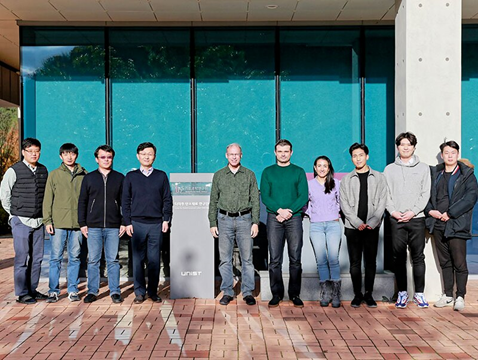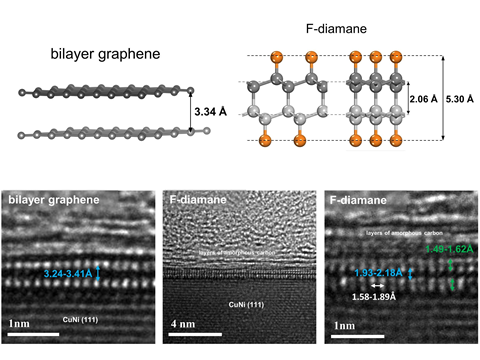News
Prof. Zonghoon Lee’s Atomic-Scale Electron Microscopy Lab
Prof. Zonghoon Lee’s Atomic-Scale Electron Microscopy Lab

[English ver.]
Synthesis of the thinnest possible diamond-like material starting from bilayer graphene and without high pressure
Can two layers of the “king of the wonder materials,” i.e. graphene, be linked and converted to the thinnest diamond-like material, the “king of the crystals”? Researchers of the Center for Multidimensional Carbon Materials (CMCM) within the Institute for Basic Science (IBS, South Korea) have reported in Nature Nanotechnology the first experimental observation of a chemically induced conversion of large-area bilayer graphene to the thinnest possible diamond-like material, under moderate pressure and temperature conditions. This flexible, strong material is a wide-band gap semiconductor, and thus has potential for industrial applications in nano-optics, nanoelectronics, and can serve as a promising platform for micro- and nano-electromechanical systems.
Diamond, pencil lead, and graphene are made by the same building blocks: carbon atoms (C). Yet, it is the bonds’ configuration between these atoms that makes all the difference. In a diamond, the carbon atoms are strongly bonded in all directions and create an extremely hard material with extraordinary electrical, thermal, optical and chemical properties. In pencil lead, carbon atoms are arranged as a pile of sheets and each sheet is graphene. Strong carbon-carbon (C-C) bonds make up graphene, but weak bonds between the sheets are easily broken and in part explain why the pencil lead is soft. Creating interlayer bonding between graphene layers forms a 2D material, similar to thin diamond films, known as diamane, with many superior characteristics.
Previous attempts to transform bilayer or multilayer graphene into diamane relied on the addition of hydrogen atoms, or high pressure. In the former, the chemical structure and bonds’ configuration are difficult to control and characterize. In the latter, the release of the pressure makes the sample revert back to graphene. Natural diamonds are also forged at high temperature and pressure, deep inside the Earth. However, IBS-CMCM scientists tried a different winning approach.
The team devised a new strategy to promote the formation of diamane, by exposing bilayer graphene to fluorine (F), instead of hydrogen. They used vapors of xenon difluoride (XeF2) as the source of F, and no high pressure was needed. The result is an ultra-thin diamond-like material, namely fluorinated diamond monolayer: F-diamane, with interlayer bonds and F outside.
For a more detailed description; the F-diamane synthesis was achieved by fluorinating large area bilayer graphene on single crystal metal (CuNi(111) alloy) foil, on which the needed type of bilayer graphene was grown via chemical vapor deposition (CVD).
Conveniently, C-F bonds can be easily characterized and distinguished from C-C bonds. The team analyzed the sample after 12, 6, and 2-3 hours of fluorination. Based on the extensive spectroscopic studies and also transmission electron microscopy, the researchers were able to unequivocally show that the addition of fluorine on bilayer graphene under certain well-defined and reproducible conditions results in the formation of F-diamane. For example, the interlayer space between two graphene sheets is 3.34 angstroms, but is reduced to 1.93-2.18 angstroms when the interlayer bonds are formed, as also predicted by the theoretical studies.

“This simple fluorination method works at near-room temperature and under low pressure without the use of plasma or any gas activation mechanisms, hence reduces the possibility of creating defects,” points out Pavel V. Bakharev, the first author and co-corresponding author.
Moreover, the F-diamane film could be freely suspended. “We found that we could obtain a free-standing monolayer diamond by transferring F-diamane from the CuNi(111) substrate to a transmission electron microscope grid, followed by another round of mild fluorination,” says Ming Huang, one of the first authors.
Rodney S. Ruoff, CMCM director and professor at the Ulsan National Institute of Science and Technology (UNIST) notes that this work might spawn worldwide interest in diamanes, the thinnest diamond-like films, whose electronic and mechanical properties can be tuned by altering the surface termination using nanopatterning and/or substitution reaction techniques. He further notes that such diamane films might also eventually provide a route to very large area single crystal diamond films.
[Korean ver.]
- 그래핀의 변신…두께 0.5nm 초박막 다이아몬드(F-다이아메인)로 -
세상에서 가장 얇은 다이아몬드가 등장했다. 기초과학연구원(IBS, 원장 노도영) 다차원 탄소재료 연구단 로드니 루오프 단장(UNIST 자연과학부 특훈교수) 연구팀은 울산과학기술원(UNIST)과 공동으로 간단한 공정만으로 그래핀을 다이아몬드 박막으로 변신시키는 데 성공했다.
그래핀과 다이아몬드는 모두 탄소(C) 원자로만 이뤄져 있지만, 원자의 결합형태가 다르다. 그래핀은 탄소 원자가 주변 탄소 원자 3개와 결합(sp2 결합)하여 육각형 벌집 모양을 이룬 평면 소재다. 반면, 다이아몬드는 중심의 탄소 원자 1개가 주변 4개의 탄소 원자와 결합(sp3 결합)하여 만든 정사면체가 상하좌우로 끊임없이 반복되는 구조다.
이러한 결합 차이로 인해 두 물질은 서로 다른 물성을 갖는다. 그래핀은 강도가 높고, 열과 전기를 잘 전달하는 것은 물론 2차원 물질이기 때문에 자유자재로 휘어진다. 반면, 다이아몬드는 뛰어난 열전도성과 기계적 강도를 가졌지만 전기가 통하지도 않고, 쉽게 휘어지지 않는다.
다이아몬드를 2차원 평면 형태로 제작할 경우 다이아몬드의 우수한 물성을 반도체 소자를 비롯한 전기, 기계, 화학 등 다양한 분야에 폭넓게 이용할 수 있다. 이 때문에 그래핀의 결합구조에 변화를 줘 그래핀처럼 얇은 초박막 다이아몬드 즉, ‘다이아메인(Diamane)’을 합성하려는 연구가 등장했지만 아직 상용화에 이르지는 못했다. 결합구조를 변화시키는 과정에 매우 높은 압력이 필요해 제조비용이 비쌀뿐더러 압력이 낮아지면 다시 그래핀으로 돌아가는 등 안정성을 유지하지 못했기 때문이다.
연구진은 2개의 그래핀이 쌓인 구조의 이중층 그래핀으로 대기압에서도 안정적인 다이아메인을 세계 최초로 합성했다. 연구진이 개발한 공정은 상온‧저압 조건에서 화학적 처리만을 거쳐 다이아메인을 합성할 수 있기 때문에 고압이 필요하던 기존 기술 대비 제조비용을 대폭 줄일 수 있다는 장점도 있다.
공동 교신저자이자 제1저자인 파벨 바카레브 연구위원은 “다층 그래핀을 다이아메인으로 변환시키기 위한 연구가 많이 보고됐지만, 제조과정이 복잡하거나 구조에 결함이 있는 경우가 많았다”며 “우리 연구진은 불소를 주입하는 과정(불소화 과정)을 통해 간단히 그래핀의 탄소결합(sp2)을 다이아몬드와 같은 결합(sp3)형태로 바꿨고, 결함 역시 최소화했다”고 설명했다.
우선 연구진은 화학기상증착법(CVD)을 이용해 구리니켈(CuNi) 합금 기판 위에서 이중층 그래핀을 제작한 뒤, 불소 기체를 주입했다. 주입된 불소는 그래핀과 화학반응을 일으키며 두 층간에서 탄소결합이 생기도록 유도한다. 주변 3개의 원자와 결합하던 탄소가 4개의 주변 원자와 결합하게 되고, 최종적으로 필름 형태의 다이아몬드가 만들어진다. 불소(F)화 과정을 통해 합성했다는 의미에서 연구진은 이 초박형 다이아몬드를 ‘F-다이아메인’으로 명명했다. 연구진이 합성한 F-다이아메인의 두께는 0.5nm에 불과하다.
로드니 루오프 단장은 “유사 다이아몬드 구조체 합성을 통해 다이아몬드의 우수한 물성을 다양한 분야에 사용할 수 있는 길을 연 것”이라며 “향후 전기적·기계적 특성까지 조절 가능한 대면적 단결정 다이아몬드 필름을 구현하는 연구를 진행할 계획”이라고 말했다.
연구결과는 국제학술지 네이처 나노테크놀로지(Nature Nanotechnology․IF 33.407) 12월 10일(한국시간) 온라인 판에 실렸다.